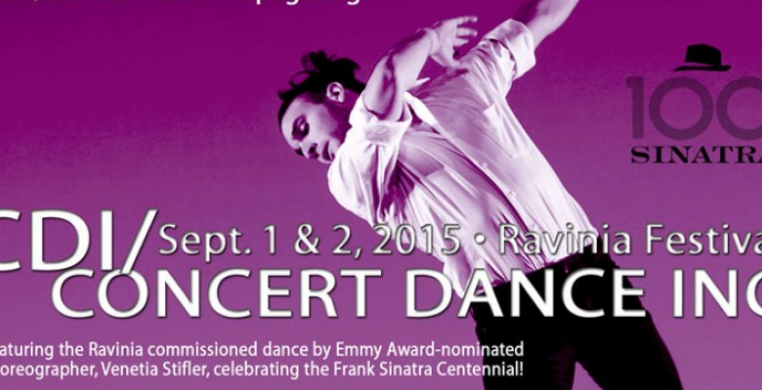The Ruth Page Festival of Dance opened at Ravinia’s Bennett Gordon Hall with Concert Dance, Inc. in a musically diverse program of four works by CDI artistic director, Venetia Stiffler. The concerts September 1st and 2nd mark the farewell performances of CDI dancers Victor Alexander and Maray Gutierrez, a sad loss for the company, as they are the strongest and artistically most mature among the six who danced Tuesday night.
Stiffler, who moderated the evening with commentary on each of the pieces, credits Ravinia President and CEO Welz Kauffman with the inspiration behind musical choices for the three Ravinia-commissioned works, two of which were performed to live, on-stage music. Fittingly for its venue, great music was the central focus of the program.
“El Salon Mexico,” (2010, Ravinia Commission) set to the familiar music of the same name by Aaron Copeland and performed by duo-pianists Kay Kim and Susan Tang, is a sunny romp for six dancers who emerge from the subdued stasis of a giant picture frame. Once free of the confines of the picture frame--read metaphor here--they are free to pursue flirtatious fantasies in lively sequences that cover ground in sweeping arcs, leggy ronds de jambes en l’air, and supported sissor-kicks. Stiffler makes good use of the space, with ever-shifting sculptural configurations that take the dancers swiftly into the air, to the floor, and back onto their feet. They variously fall into each other, pull an outstretched leg into arabesque, or circle an arm into a spiral turn, pausing briefly for the occasional mis en scène of a group picture inside the frame. Stiffler’s take on the Copeland score includes a brief nod to the shoulder isolations of Latin dance moves, but otherwise has little use for the distinctive south-of-the-border rhythms that characterize the music. Instead of a visceral response to the specifics of its structure and musical dynamics, the movement reflects the music’s frolicsome mood as the basis for a loosely narrative story structure that focuses on character delineation in a process of self-discovery through relationship.
While “Four Last Songs” (2014 Ravinia Commission) is set to Richard Strauss’s poignant and profound last gift to art song, it had little to do with the music, performed live on stage by soprano Christina Kaloyanides and pianist Kay Kim. Stiffler described the music aptly as worldly and transcendental, but the choreography was anything but. While technically proficient, the dancing felt effortful and deliberate, an intellectualization of an emotional journey. On the plus side, Stiffler cast her singer as a character, in spatial relationship to the dancers, which opened the potential for a fascinating collaboration of music and dance, musician and dancers. Strong visuals carried the day, with beautifully-designed group configurations that told the story and held interest. There was community and loss, coming together and separation in a story that illustrated the passing of seasons as the trajectory into the waning years of life, again emphasizing narrative content over musical substance. A translation of the lyrics might have been helpful in guiding our understanding of the relationship between the music and the choreography, which was lyrical and pleasant with a movement vocabulary that mirrored the previous piece. But instead of a symbiotic relationship between the two, the dance seemed to exist in a parallel universe, telling the story of the lyrics but not reflective of Strauss’s musical depths. Jacob Snodgrass’s limited access to dance-friendly lighting in the Bennett Gordon had an especially unkind effect on Vin Reed’s unisex costuming of mid-calf length gray culottes.
It takes gumption to choreograph in the wake of Twyla Tharp’s brilliant “Nine Sinatra Songs,” in which the choreographer blazed a stunning path to the blend of classical dance technique with pop music and dance idioms on the concert dance stage. To its credit, “Fly Me To The Moon” (World Premiere Ravinia Commission) brought Sinatra the man on stage in the form of voice-overs of Old Blue Eyes talking about his life and his art, a fitting touch in commemoration of the 100th anniversary of his birth, and as a prelude to Frank Sinatra Jr.’s tribute to his dad with the Ravinia Festival Orchestra this Friday. Admittedly “not jazz dance” as Stiffler described her take on the master, the movement relied on peripheral gesture to drive locomotion, which contrasted the music with a puzzlingly prosaic quality, perhaps meant to reflect the everyday-ness of living. The dancing had a hard time matching the gutsy honesty of Sinatra’s singing and the vulnerability of his speaking voice. It finally caught fire in a spunky female solo to the title song, with percussive attack that accentuated the impulse-driven music and caught the spirit of the song.
The evening wrapped up on a high note with “Meetings Along The Edge” (2007), which connected to its music in a substantive way. Iranian popular music fueled Part I in a beautifully-danced duet for Maray Gutierrez and Mary O’Rourke that integrated the music with the spatial and rhythmic structure of the dance to make a strong impact on the meaning of relationship. The movement met the dancers outside the comfort zone of societal norms and took risks we hadn’t seen before with balance, contact, and shape. The quintet of Part II capitalized on the driving repetitive pulse of music by Philip Glass and Ravi Shankar to capture the high-stakes enterprise of coupling and breaking apart. Movement vocabulary reflected Stiffler’s reliance on fan kicks and leverage and her stylistic signature of sweeping arms into spiral turns. Strong use of the space with flights of quick-paced group locomotion that congeal momentarily in sculptural design characterize much of Stiffler’s work in this program. Ironically, this was the only piece where the music was least dominant, and yet most effectively integrated into the whole. All taken, music was the message.

